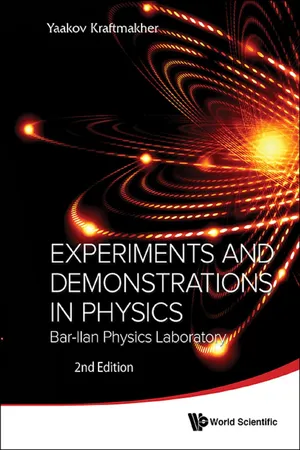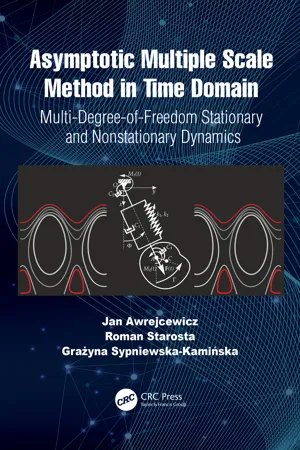Physics
Torsional Pendulum
A torsional pendulum is a physical system used to study the behavior of torsional oscillations. It consists of a horizontal rod or wire suspended from a fixed point, with a mass attached to one end. When the mass is twisted and released, it undergoes angular oscillations about the axis of the rod or wire. The period of these oscillations depends on the torsional constant and the moment of inertia of the system.
Written by Perlego with AI-assistance
Related key terms
Related key terms
1 of 4
Related key terms
1 of 3
3 Key excerpts on "Torsional Pendulum"
- eBook - ePub
- William Bolton(Author)
- 2012(Publication Date)
- Routledge(Publisher)
11 A pendulum which has a periodic time of 1.000 s when its support is stationary is placed in a lift which ascends with an acceleration of 0.02 m/s. What effect will this have on the periodic time?ActivityConstruct a simple pendulum by suspending a small ball of metal from the end of a light thread. Measure the length L of the pendulum from its point of support to the centre of gravity of the bob. Determine the time taken for, say, 20 oscillations when the pendulum bob is given a small displacement. Hence, obtain a value for the periodic time T. Repeat the experiment for a number of different values of L. Equation [20 ] can be written as:Thus a graph of T2 against L will be a straight line with a slope of 4π2 /g. Hence, from a measurement of the slope of such a graph, obtain a value for the acceleration due to gravity g.6.3.4 Torsional oscillationsConsider a disc, with moment of inertia I about an axis at right angles to its plane and through its centre, which is mounted on a central axial slender shaft (Figure 6.14 ). When the disk is rotated through some angle θ, the shaft is twisted. The restoring torque T produced by this twist is proportional to θ (see Chapter 3 and equation [10 ], i.e. T = GθJ/L with G = shear modulus, J = polar second moment of area and L = length), thus:Figure 6.14 Torsional oscillationsrestoring torque = −kθwhere k is the torque per radian twist or torsional stiffness (see note above, it is GJ/L). When the system is released and allowed to oscillate then:restoring torque = Ia = −kθThe oscillation is thus angular simple harmonic and so, using equation [21 ]:[22] ExampleA flywheel of mass 30 kg and radius of gyration 150 mm about its central axis is attached centrally to one end of a slender shaft, the other end being effectively clamped. The shaft has a torsional stiffness of 1.6 kN m/rad. Determine its frequency of oscillations when the flywheel is given an initial angular displacement and then released. - eBook - ePub
Experiments and Demonstrations in Physics
Bar-Ilan Physics Laboratory
- Yaakov Kraftmakher(Author)
- 2014(Publication Date)
- WSPC(Publisher)
Fig. 1. Schematic of the experiment.Weighing a swinging pendulum allows determinations of the centripetal force on the pendulum bob. This force reaches a maximum when the bob passes its lower position, two times a period. A steel ball and a thread form a pendulum (Fig. 1 ). The thread is attached to the Force sensor, which measures the vertical component of the tension. For small-angle oscillations, the angular position of the pendulum iswhere ω2 = g/l, l is the length of the pendulum, θo is the maximum angular displacement; the initial phase of the oscillations is taken zero. The angular velocity of the pendulum is θ′ = ωθo cosωt. The centripetal force equalswhere m is the mass of the bob, and v is its linear velocity.The maximum kinetic energy equals the potential energy at the point of maximum deflection θo :The maximum centripetal force thus isFor θo = 90°, the maximum centripetal force is twice the weight of the bob. The tension T in the pendulum thread is the sum of the bob weight component along the thread and of the centripetal force:The vertical component of the tension equalsFor small angles, cosθ ≈ 1 – θ2 /2. Neglecting terms involving powers of θ greater than two,At the lower position of the pendulum (θ = 0, ωt = 0),while at the upper position (θ = θ0 , ωt = π/2),For small-angle oscillations, the weight measured by the Force sensor oscillates with an amplitude ΔTv = mgθ0 2 ; the frequency of the oscillations is 2ω. In our setup, m = 45 g, and l = 30 cm. The maximum displacement of the pendulum is determined with a scale positioned behind the pendulum. A small permanent magnet attached to the bob and a coil positioned under the pendulum serve for detecting the instants when the pendulum passes its lower position. The voltage induced in the coil is measured with the Voltage sensor and displayed by the Graph tool, along with the force measured by the Force sensor (Fig. 2 ). It is seen that the maximum force is reached when the bob passes its lower position. The initial weight of the pendulum is excluded using the Tare button of the Force sensor. From the measurements, the maximum kinetic energy of the pendulum, mv0 2 /2, is determined through ΔTv = mv0 2 /l, so that mv0 2 /2 = lΔTv /2. This kinetic energy can be compared with the maximum potential energy of the pendulum, mglsinθ0 - eBook - ePub
Asymptotic Multiple Scale Method in Time Domain
Multi-Degree-of-Freedom Stationary and Nonstationary Dynamics
- Jan Awrejcewicz, Roman Starosta, Grażyna Sypniewska-Kamińska(Authors)
- 2022(Publication Date)
- CRC Press(Publisher)
7 Torsional Oscillations of a Two-Disk Rotating SystemDOI: 10.1201/9781003270706-7In this chapter, the problem of coupled and periodically driven torsional oscillators is analyzed. The system consists of a harmonic oscillator of a large mass to which a nonlinear oscillator of much lower mass is connected. From the mathematical model, the internal motion is separated and then the approximate effective equation of motion is derived. This equation is transformed to a first-order differential equation for complex functions and then efficiently solved in the vicinity of main resonance using the multiple scale method. A detailed analysis of transient vibrations is carried out, which allows us to determine the critical values of the nonlinearity parameter for which there is a qualitative change in the dynamics of the system. For the steady motion, the amplitude-frequency dependencies are determined, the curves of the resonance response were plotted and their stability tested.7.1 Introduction
The exchange of energy is a subject of great interest to many researchers. Especially, nonlinear properties of elasticity or damping have big application potentials ([184 ], Gendelman et al. [76 ], Vakakis and Gendelman [216 ], Gendelman [74 , 75 ], Kerschen et al. [96 ], Manevitch et al. [134 ]). It could be crucial in the tasks of control or designing of the passive damping systems. Such a method has been firstly proposed in the paper (Haxton and Barr [82 ]). Many less or more similar approaches are widely discussed in the review article (Oueini et al. [162 ]). Determining the conditions in which this phenomenon occurs allows for the appropriate selection of the parameters of the system in order to transfer energy from one part to another. Coupled oscillators play an important role in many fields of science, including mechanics, medicine and biology (Awrejcewicz [17 ], Kozłowski et al. [105
Index pages curate the most relevant extracts from our library of academic textbooks. They’ve been created using an in-house natural language model (NLM), each adding context and meaning to key research topics.
Explore more topic indexes
Explore more topic indexes
1 of 6
Explore more topic indexes
1 of 4


